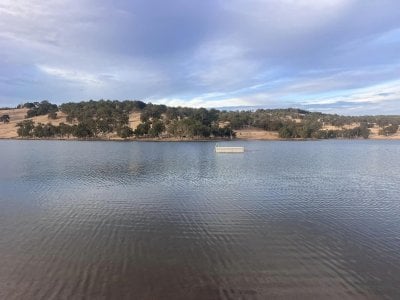Swimmers beware: This deadly danger at a popular spot could put your life at risk
Australia is blessed with some of the world's most beautiful beaches, rivers, and swimming spots. They're the perfect escape from the heat, especially as temperatures soar.
But sometimes, these idyllic spots can harbour hidden dangers that are not only unexpected but potentially deadly.
Recently, authorities warned swimmers to avoid a popular spot over fears that a deadly amoeba was discovered in the water.
Drakesbrook Weir, located more than 100 km south of Perth, is usually a bustling location for those looking to cool off, but recent findings have prompted a serious warning: stay out of the water.
The Shire of Waroona Council issued an urgent warning after tests indicated the presence of Naegleria amoeba in the water.
‘Testing this week has again indicated the presence of Naegleria amoeba in the water,’ the council announced.
‘The Shire is now awaiting results to rule out the presence of Naegleria fowleri, the organism responsible for amoebic meningoencephalitis, commonly referred to as amoebic meningitis,’ they added.
Amoebic meningoencephalitis is a serious illness that causes inflammation in the brain and has a 99 per cent fatality rate.
The amoeba poses a threat when water containing the organism is forced up a person's nose, which can happen easily during a swim or a dive.
From there, it travels to the brain, where it multiplies and consumes brain tissue, leading to severe infection and, in most cases, death.
The council has advised anyone who has recently swum at Drakesbrook Weir and is feeling unwell to seek immediate medical attention.
This isn't the first time such a warning has been issued; similar alerts were raised in January and February.
Health Department Managing Scientist Richard Theobald has emphasised the deadly nature of this amoeba, stating that while infection is rare, the consequences are almost always fatal.
In Western Australia, there have been three known cases since the 1980s.
Water Researcher Professor Ian Wright described amoebic meningitis as a 'horrible, horrible thing,' noting that while the chances of infection are low, the outcome for those infected is grim.
‘You could probably have a thousand people swim in that waterway and not get it. But if you get infected, it's likely fatal. It takes between one and 18 days to die,’ he said.
On the other side of the country, in Sydney, a different but equally dangerous marine creature has been spotted.
A blue-ringed octopus, known for its deadly venom, was spotted at popular swimming baths in Woolwich.
Professor of Marine Ecology at the University of Technology Sydney (UTS), David Booth, expressed his surprise at finding the octopus so far up the harbour, as they are typically seen at ocean beaches.
These incidents serve as a reminder that our beloved swimming spots can sometimes turn into danger zones. It's crucial to stay informed about the conditions of your local waterways, heed warnings from local councils and health departments, and always err on the side of caution.
Remember to check for updates on water quality before you plan your next swim, and if you're ever in doubt, it's best to stay out.

What are your thoughts on this story, members? Have you visited Drakesbook Weir? Let us know in the comments below.
But sometimes, these idyllic spots can harbour hidden dangers that are not only unexpected but potentially deadly.
Recently, authorities warned swimmers to avoid a popular spot over fears that a deadly amoeba was discovered in the water.
Drakesbrook Weir, located more than 100 km south of Perth, is usually a bustling location for those looking to cool off, but recent findings have prompted a serious warning: stay out of the water.
The Shire of Waroona Council issued an urgent warning after tests indicated the presence of Naegleria amoeba in the water.
‘Testing this week has again indicated the presence of Naegleria amoeba in the water,’ the council announced.
‘The Shire is now awaiting results to rule out the presence of Naegleria fowleri, the organism responsible for amoebic meningoencephalitis, commonly referred to as amoebic meningitis,’ they added.
Amoebic meningoencephalitis is a serious illness that causes inflammation in the brain and has a 99 per cent fatality rate.
The amoeba poses a threat when water containing the organism is forced up a person's nose, which can happen easily during a swim or a dive.
From there, it travels to the brain, where it multiplies and consumes brain tissue, leading to severe infection and, in most cases, death.
The council has advised anyone who has recently swum at Drakesbrook Weir and is feeling unwell to seek immediate medical attention.
This isn't the first time such a warning has been issued; similar alerts were raised in January and February.
Health Department Managing Scientist Richard Theobald has emphasised the deadly nature of this amoeba, stating that while infection is rare, the consequences are almost always fatal.
In Western Australia, there have been three known cases since the 1980s.
Water Researcher Professor Ian Wright described amoebic meningitis as a 'horrible, horrible thing,' noting that while the chances of infection are low, the outcome for those infected is grim.
‘You could probably have a thousand people swim in that waterway and not get it. But if you get infected, it's likely fatal. It takes between one and 18 days to die,’ he said.
On the other side of the country, in Sydney, a different but equally dangerous marine creature has been spotted.
A blue-ringed octopus, known for its deadly venom, was spotted at popular swimming baths in Woolwich.
Professor of Marine Ecology at the University of Technology Sydney (UTS), David Booth, expressed his surprise at finding the octopus so far up the harbour, as they are typically seen at ocean beaches.
These incidents serve as a reminder that our beloved swimming spots can sometimes turn into danger zones. It's crucial to stay informed about the conditions of your local waterways, heed warnings from local councils and health departments, and always err on the side of caution.
Remember to check for updates on water quality before you plan your next swim, and if you're ever in doubt, it's best to stay out.
Key Takeaways
- Swimmers have been warned to avoid Drakesbrook Weir due to the potential presence of the deadly Naegleria amoeba.
- Testing indicated the presence of the amoeba, and the council is awaiting further results to confirm if it is the particularly harmful Naegleria fowleri strain.
- If water containing the amoeba is forced up the nose, it can cause a highly fatal condition called amoebic meningoencephalitis.
- Health authorities have reminded the public about the rarity but high fatality rate of infections, and there have been three known cases in Western Australia since the 1980s.
Last edited by a moderator:








